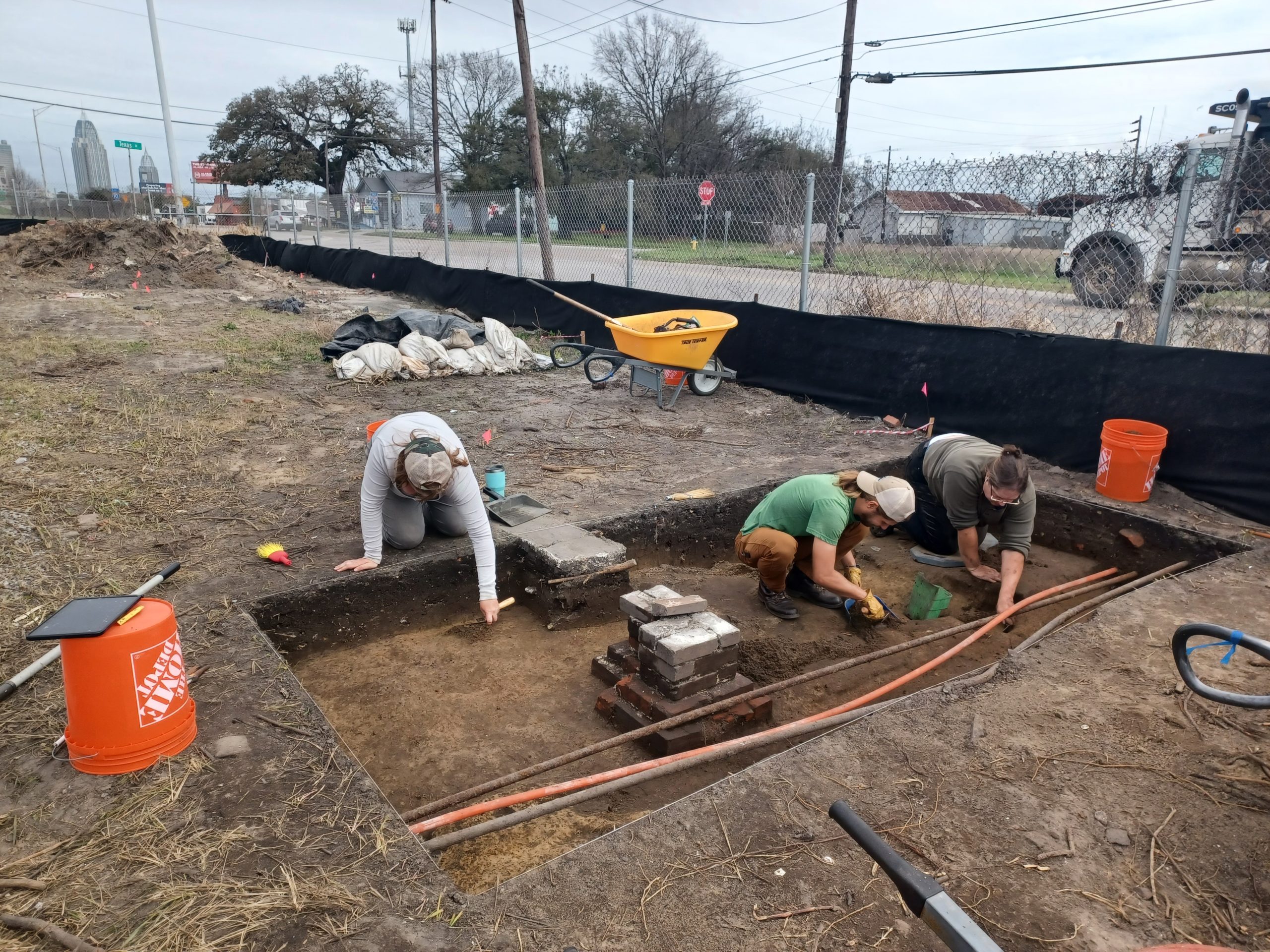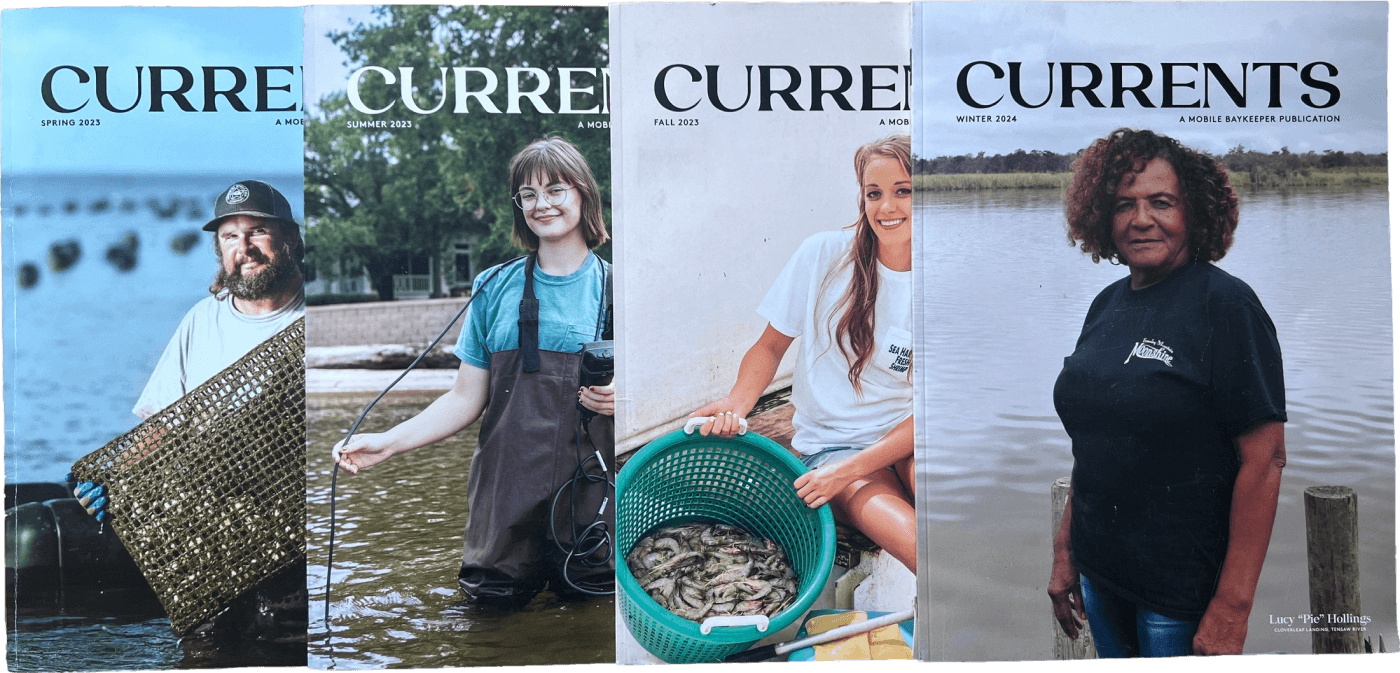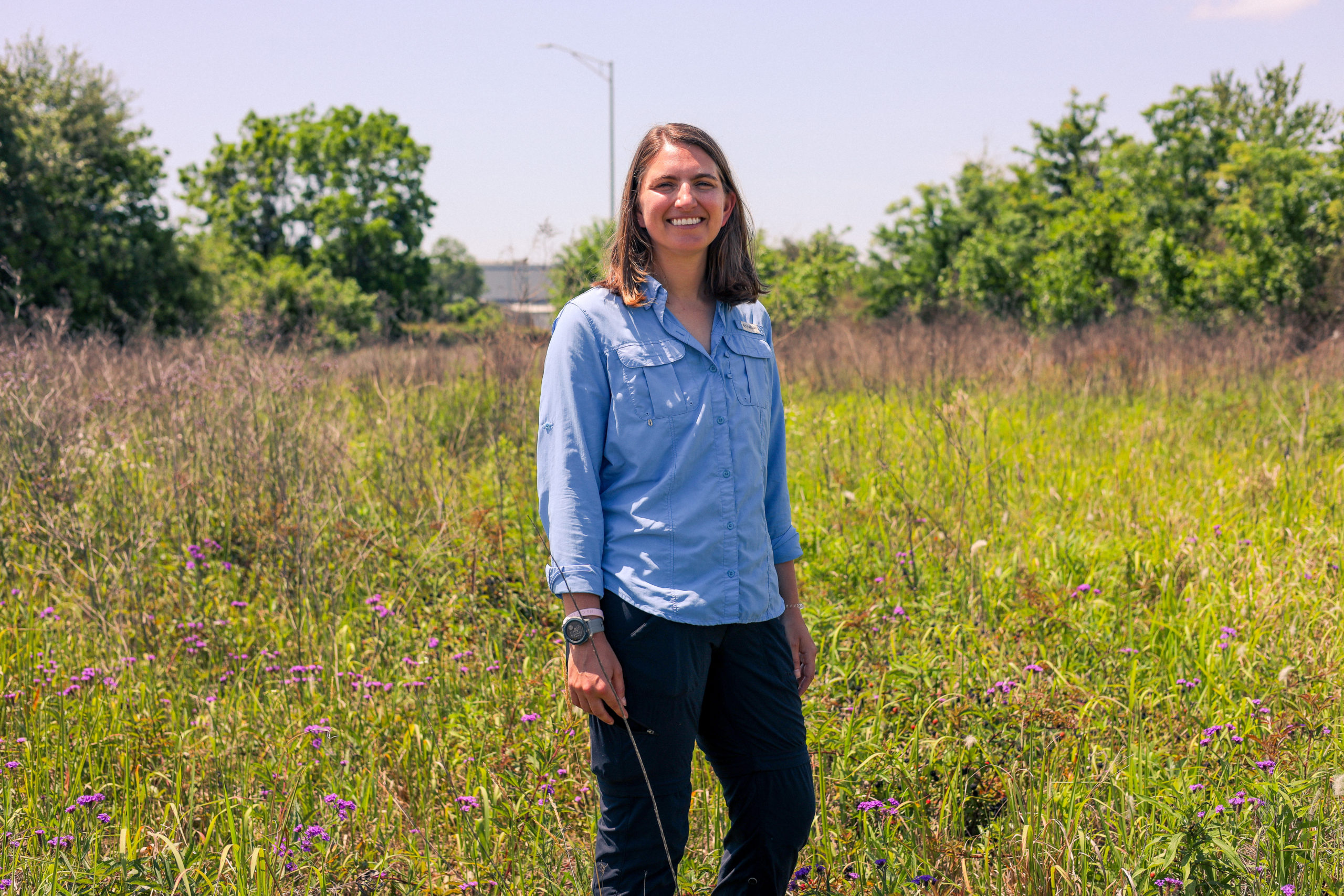
This article is from the summer 2025 edition of Mobile Baykeeper’s print quarterly, CURRENTS. The magazine is mailed to active members who have given more than $50 in the past year. To get on the magazine’s mailing list, donate here.
By Nick Williams | Photos by Courtney Mason
By all appearances, it’s just another infrastructure upgrade — a bridge expansion, a highway rerouting. But under the planned path of the I-10 Mobile River Bridge, beneath layers of asphalt and fill, the past has been quietly waiting. Thanks to a partnership between the University of South Alabama’s archaeology team and Wiregrass Archaeological Consulting, and with the support of project leaders, this moment of development has turned into a rare opportunity to reconnect with Mobile’s long, layered, and deeply human history.
At the heart of this endeavor is Rachel Hines, an archaeologist with a passion not just for what’s buried underground, but for the people those remnants belonged to — and the people today who deserve to know those stories.
“Why are we doing it if we’re not sharing it?” Hines asks. And she means it.
As the first-ever Public Outreach Coordinator on an archaeological project at the University of South Alabama, Rachel Hines isn’t just focused on what gets unearthed — she’s focused on who gets to hear about it. Her role was created specifically for the I-10 Mobile River Bridge Archaeology Project, a visionary move by Principal Investigator Dr. Phil Carr, who understood from the beginning that a project of this scale and significance needed a dedicated voice for the public.
“There’s not usually someone in this role on archaeology projects,” Hines says. “A lot of the focus is on doing the work, and not as much about getting the message out there.” With no previous model to follow, she had the freedom — and the challenge — of building the outreach strategy from scratch. “It was a double-edged sword,” she admits. “There weren’t any guidelines or handbooks to go by, but it also meant I got to shape it into something meaningful.”
From Alaskan Wilds to Urban Archaeology
Hines came to the position with a deep understanding of both fieldwork and public engagement. After earning her undergraduate degree in anthropology from the University of Minnesota, she spent several years working seasonally with the National Park Service and the U.S. Forest Service. Her work took her across the country, from remote Alaskan parks accessible only by bush plane to the deserts of Death Valley and the forests of northern California.
“I worked at probably about half the parks in Alaska,” she recalls. “We’d fly out into the middle of nowhere, make a base camp, and just hike out from there to record whatever sites we could find. It was amazing.” But while she loved the adventure and the scientific rigor of that work, something was missing.
“What I got kind of frustrated about was that we were always doing really cool work, but there weren’t a lot of outlets to share it,” she says. “We were just always working hard, but we weren’t making museum exhibits or giving public talks. That part — communicating the story — wasn’t built in.”
That realization led her back to school for a master’s in historical archaeology at the University of West Florida, where she was drawn to the Florida Public Archaeology Network (FPAN), a statewide initiative that pioneered ways to engage the public in archaeology. “FPAN was a big reason I chose UWF,” she says. “They’re all about making archaeology accessible — working with schools, museums, communities. I knew I wanted to be part of that.”
At South Alabama, she’s been able to put those dual passions — field archaeology and public education — into action. Her outreach efforts for the I-10 project have included everything from coordinating news coverage and producing educational videos to developing traveling exhibits and building classroom kits using real artifacts. She’s taught public lectures, collaborated with local schools, and designed downloadable lesson plans to ensure the work lives on long after the dig is done.
A constant thread in all of it is her belief that archaeology only matters if it’s shared. “Even if we collect all this data and write up the reports, if the public never sees it, what’s the point?” she says. “It becomes this thing that only lives in our intellectual community. But archaeology is about people. It belongs to everyone.” And in Mobile — a city where residents are deeply invested in their heritage — that message is resonating. “People here are incredibly connected to their history,” Hines says. “You feel it when you talk to them. So the response has been amazing. They want to know what we’re finding. They want to know what it means.”
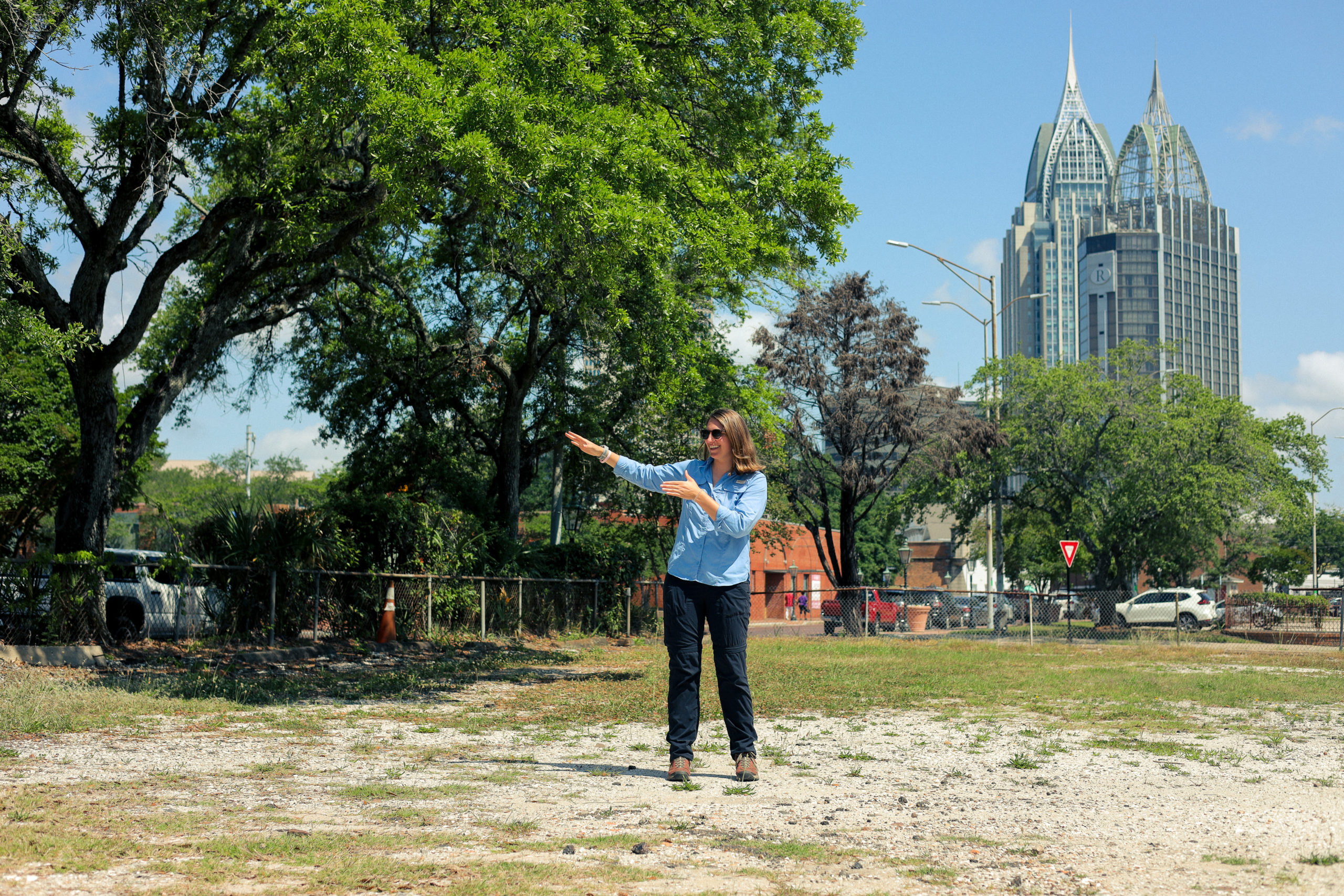
A City Built in Layers
Mobile isn’t just an old city — it’s a city built in layers. For centuries, people have lived, worked, and built their lives in the same space, often directly atop the remnants of the past. The I-10 Mobile River Bridge Archaeology Project has revealed this reality, unearthing a remarkable cross-section of cultures and time periods.
“At one of our sites, we found Woodland-period ceramics — Native American pottery probably made about 2,000 years ago — right beneath a shotgun house from the early 1900s,” says Rachel. “People have been living on top of where others lived for thousands of years.”
What makes Mobile especially distinctive is its history of rapid colonial succession. In just a few decades, the city shifted hands among the French, British, Spanish, and eventually Americans — each leaving behind material clues in the form of pottery, architecture, and everyday items.
“We can see the difference between French, Spanish, and British pottery. It all looks different, so we can identify them archaeologically,” Hines explains. “It’s exciting because you have all these cultures coming together in one area, interacting with each other.”
Among the imported artifacts were fragments of Spanish majolica. “It was made in Mexico using Spanish pottery methods and local Mexican clay,” Hines notes. The result reflects both European techniques and Indigenous materials — a vivid example of cultural blending during the colonial era. Some pieces are undeniably local: a Mardi Gras badge from 1896, a Mobile streetcar token from 1916, and ceramic fragments labeled “Mobile Pottery,” produced by a kiln operated by Millard Fillmore Kirkbride, who grew up in the Kirkbride House. “The Kirkbride house is now the Condé-Charlotte house,” Hines says. “That family had a brick kiln.”
Mobile’s landscape tells a story of change and human engineering. “At least three of our sites didn’t even exist before 1820,” she says. “There was no habitable land there. It was a swamp. That area was filled in during the 1820s and 1830s. They built the land, then built on top of it.”
The I-10 archaeology project spans 15 excavation sites — 13 in Mobile County and two across the Bay in Baldwin County. But its scale alone isn’t what makes it extraordinary. What sets it apart is the surprising preservation of sites beneath infrastructure and industrial zones.
“That was what surprised me most,” Hines admits. “Even right next to the pilings — basically under the interstate at the ‘RV City’ area where everybody parks for Mardi Gras — we found intact archaeological sites.”
These urban sites vary widely: residential homes, small businesses, lumber mills, even entire city blocks. “Our oldest artifact is about 2,000 years old,” Hines says. “People lived there through the 1960s, until the interstate was built and they were forced to leave.”
These artifacts and structures offer more than isolated snapshots. They document how ordinary people lived and adapted through centuries of change — how neighborhoods evolved, how trade and industry shaped daily life, and how Mobile’s past remains present, if you know where to look.
“These sites on the periphery of downtown can tell us about people whose lives aren’t well-documented,” Hines says. And that, perhaps, is what makes the project so compelling. It’s not just about old objects or broad historical trends. It’s about personal stories and the enduring continuity of life in a city continually remade.
Preserving the Past Before Paving Over It
Before a single piling was driven or a construction bid released for the I-10 Mobile River Bridge, archaeologists had already spent years studying the ground it would cross. This was required by the National Historic Preservation Act (NHPA) of 1966, a federal law mandating the evaluation of historic and archaeological resources before federally funded projects can proceed.
“It really came out of, ironically, projects such as the original interstate constructions and other large urban renewal efforts that led to the loss of many historic buildings,” says Hines. “But the law was written to cover all historic properties — protecting not just buildings, but also subsurface cultural resources, including archaeological sites and materials.”
In Mobile, this protection applied because the bridge is being built by the Alabama Department of Transportation (ALDOT) but funded by the Federal Highway Administration. “So they knew that when they moved forward with the bridge, archaeologists would need to do the work beforehand,” she says.
That process began decades ago. “We’ve actually been involved with the I-10 bridge since the ’90s or early 2000s,” Hines says. “When a project is even under consideration, we start with what’s called a Phase I survey.”
Phase I surveys are exploratory: archaeologists dig systematic, shallow holes — shovel tests — to detect any evidence of past human activity. “It’s literally just a hole in the ground,” she says. “You’re checking for artifacts or any indication that people once lived there.”
If a site shows promise, it moves to Phase II, which explores more deeply, both physically and interpretively. “We know there are archaeological materials present, but we’re not sure if they can tell us anything new or if they’re items we already understand,” she explains. Under the NHPA, a site must offer new insights to qualify for protection or excavation.
These early investigations identified 15 significant or potentially significant sites, 13 of them in Mobile County. These became the focus of full-scale excavations from 2021 to 2023.
However, this process differs from the public’s common perception of construction crews stumbling upon graves or ancient artifacts mid-build. “People often imagine a cemetery suddenly being uncovered, halting everything,” Hines says. “But in reality, most archaeological work is planned and scheduled well in advance.”
The I-10 excavations spanned multiple areas. Some sites in Baldwin County dated to the late Woodland and Mississippian periods, reflecting precontact Native American cultures. Others were located in dense urban parts of Mobile, with artifacts ranging from ancient pottery to 1960s sidewalks. Many were directly in the path of modern infrastructure.
“A lot of fill was brought in when I-10 was built,” Hines notes. “We were down in pits over my head, but the sidewalk was still beneath us. In some areas, the old street level is much lower than you’d expect.”
While these excavations are legally required, they also reflect deeper values — especially when determining what is worth preserving. For Hines, the answer is clear: “To me, it’s the everyday perspectives that make history relatable. These were average people. What were their lives like during the major events we study?”
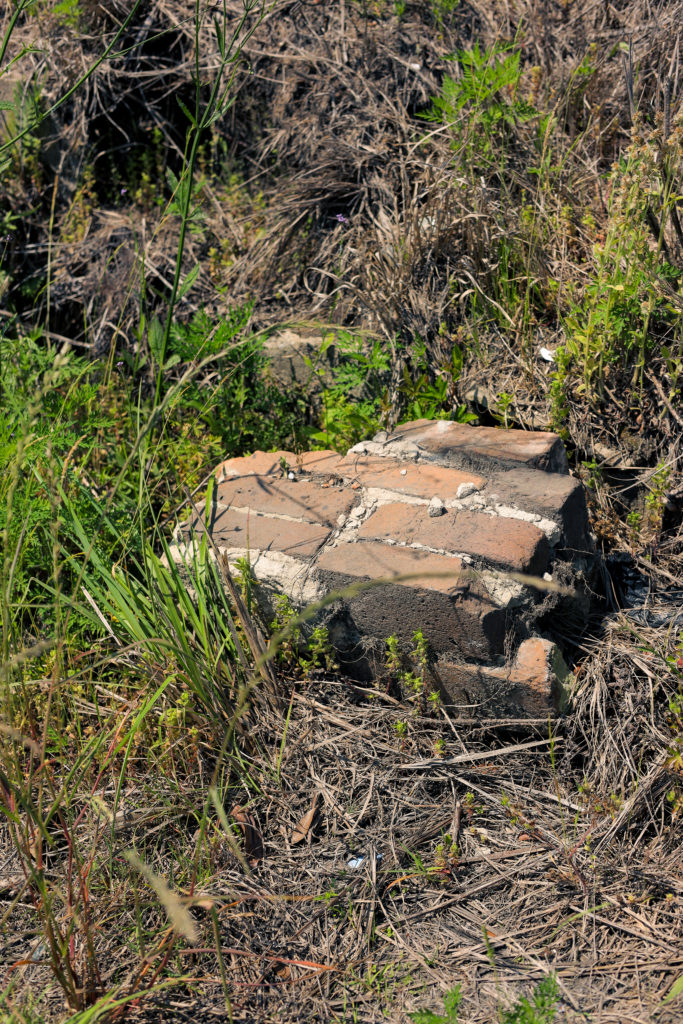

Connecting the Past to the Present
One of the most powerful outcomes of the I-10 Mobile River Bridge Archaeology Project is how it has made history personal again. This isn’t just about artifacts or old foundations — it’s about reconnecting families with their histories, restoring names to places lost to development, and making archaeological findings meaningful to the communities who once lived there.
“That’s actually one of the most exciting parts of working in an urban area,” says Hines. “We have city directories, censuses, historical maps, and various records that allow us to link individuals to the sites we’re excavating. We can often identify who lived there and sometimes even put a face to the name.”
That level of specificity is rare in archaeology. Many of Hines’ earlier projects took place in remote areas — national parks, forests, and undeveloped landscapes — where it’s often impossible to identify who left behind the artifacts. “Since I’m used to working in the backcountry, we didn’t have maps showing house locations or records of who lived there,” she says. “But in Mobile, we can say, for example, this was a particular person’s house, and these artifacts were probably used by them. That’s really exciting.”
One of the most striking examples is a site near Virginia Street, where the Owens family lived for more than sixty years — from the 1890s until their displacement by interstate construction in the 1960s. “They were a really interesting family,” Hines says. “It’s one of the only sites where someone lived continuously for six decades. Because the area was so far south of downtown, there wasn’t much other activity there, so we can say most of the artifacts were used by that family.”
The family even operated a store attached to their home, offering archaeologists a rare view into the intersection of domestic life and small business during that era. “It’s exciting to have that kind of evidence,” Hines adds.
For years, she searched for the family’s descendants — sending letters, combing through archives, and following every lead. “I spent three years trying to find people related to them,” she says. “Last week, I finally heard back from the great-grandchildren of the original homeowners. They’re in Dallas and Atlanta now, no longer in Mobile. But having that family connection, especially in an urban context, is a meaningful part of the work.”
That connection — between object and person, past and present — gives the project emotional depth. It’s not just about data or artifact counts; it’s about recovering stories that matter.
“You can find something in the dirt, but if you figure out who used it? That’s next level,” Hines says. For families whose histories are being unearthed, the work isn’t abstract — it’s personal.
Even for those without direct ties to the sites, the project resonates. “This is definitely the largest archaeological project Mobile has ever seen,” she says. “People are seeing that history is everywhere in the city — not just in one major event or discovery.”
By weaving together archaeological evidence, public records, and oral histories, Hines and her team are helping to make Mobile’s past feel immediate and alive. In doing so, they’re giving communities a chance to see themselves in the story.
Archaeology as Public Memory — and Public Responsibility
One of the most powerful aspects of the I-10 Mobile River Bridge Archaeology Project is how it reframes our understanding of where history lives — and who it belongs to. Archaeology is often imagined as distant and dramatic: ancient ruins in deserts, jungle temples, or shipwrecks at sea. But in Mobile, evidence of thousands of years of human life lay beneath interstate overpasses, parking lots, grassy medians, and forgotten foundations.
“It’s funny — people always ask, ‘Did you find anything?’” says Hines. “And I want to say, ‘Maybe ask if we found something specific, because we probably did.’ There’s so much there that people don’t realize.”
The surprise isn’t just what was found, but how well it was preserved. Even in areas thought to be too developed or disturbed — such as RV parking spots under I-10 or lots near the county jail — intact archaeological layers remained. These layers told stories of Native American communities, colonial industries, and families who lived and worked in Mobile until the mid-20th century.
But artifacts, Hines stresses, only matter in context. “The location where artifacts are is everything,” she explains. “Once they’re removed, we lose the information that comes with where they were found.” The relationships between objects, their depth in the soil, and even the type and color of surrounding dirt all help interpret their meaning.
“That’s something people don’t always understand,” she says. “We don’t just want the object — we want to know where it was, what was around it, how it was used. Dirt can tell us that. Its layers act like a timeline.”
That’s why well-meaning actions — such as pocketing pottery from a park or digging up bottles in a backyard — can do more harm than good. Instead, Hines urges people to observe, document, and report. “If you find something, take a photo, get a GPS point if you can, and send it to an archaeologist,” she advises. “That way, we can determine whether it’s part of a known site or something new.”
Curious individuals can get more involved. “We occasionally have volunteer opportunities,” she says. “Sometimes in the lab, sometimes in the field. People can reach out if they’re interested.” But public archaeology is more than joining a dig or spotting an artifact. It’s about shifting the perception of whose stories matter — and who gets to tell them.
That’s central to Hines’ work. She treats outreach not as a side effort, but as a vital part of the archaeological process. She has created traveling exhibits, including Unwritten: Archaeology and Oral History of Jim Crow Mobile, which tells the stories of the Owens, Griffins, and Lewis families. Another exhibit, Growing Up Down the Bay, developed with undergraduates, explores childhood and everyday life in Mobile neighborhoods. It was designed to be colorful, interactive, and memorable — something a child might recall years later.
“These aren’t just educational tools,” Hines says. “They’re ways to honor lives that might not appear in history books.” She has also created artifact kits for Alabama schools, using objects found on-site but not preserved for research — items discovered on the surface or outside stratified layers. These kits, along with downloadable lesson plans, have reached classrooms across the state. Through partnerships with libraries, parks, and public schools, she’s helped make archaeology accessible beyond museums and universities.
At the heart of her work is a guiding belief: archaeology is a public good, and with that comes public responsibility. “We think of clean water or air as shared benefits, even if we don’t see them,” Hines says. “But archaeology isn’t like that. If people don’t hear about what we find, there’s no benefit. It just stays locked in academic reports.”
Her work, then, is about more than outreach — it’s about equity, memory, and access. “History isn’t just about famous people or big events. It’s about regular people — those who lived where you live, who walked the same streets,” she says. “And those stories are still out there. Sometimes they’re under six feet of dirt. But they’re there.”
Ultimately, the I-10 project has become a model for public-facing archaeology: thoughtful, community-rooted, and driven by a sense of shared stewardship. By inviting the public into the process — not merely as spectators, but as participants — Hines and her team have ensured that Mobile’s buried past doesn’t stay buried. Instead, it becomes part of the city’s living memory — a past that shapes its future.
Bridging History and Habitat
The I-10 Mobile River Bridge Archaeology Project doesn’t just illuminate Mobile’s past — it also reveals a deep connection between cultural preservation and environmental stewardship. At first glance, the two may seem unrelated, but as Hines explains, they are closely intertwined.
“My cousin is about to graduate with a degree in environmental sciences, and I told him to reach out to me — our fields are basically the same,” Hines says. “They follow parallel paths. Our career options and structures really mirror each other.”
That parallel includes shared policies, such as the National Historic Preservation Act (NHPA) and the National Environmental Policy Act (NEPA), which often work in tandem during major development projects. “We’ve got the NHPA, but cultural resources are also protected under NEPA. Usually, you just coordinate Section 106 with NEPA,” she explains.
For Hines, the connection is more than procedural — it’s conceptual. “The environment is part of the archaeological site. It’s hard to separate the two,” she says. Archaeology, in her view, isn’t just about artifacts — it’s about places and how people shaped them over time.
That’s especially true in Mobile, where much of the land was engineered to meet the city’s growing needs. “At least three of our sites didn’t exist before 1820. That land was filled in during the 1820s and 1830s,” Hines says. “They built the land — and then built on top of it. That’s fascinating to see.”
Studying how people lived on and with the land offers more than historical insight — it offers a way to rethink our present relationship with space and resources. While some archaeologists speak of learning from the past to avoid mistakes, Hines sees it differently.
“My take is that we can see how people lived along Mobile Bay for thousands of years, and how their adaptations differed,” she says. “It’s less about avoiding past errors and more about expanding our imagination. Seeing those differences helps us think about new futures.”
In that sense, archaeology looks forward as much as it looks back. It contributes to conversations about how we live now and how we might live better. This perspective is shared by environmental scientists. Whether preserving wetlands or protecting cultural sites, the goal is often the same: to recognize what’s worth preserving and to act with care.
Like environmental work, archaeological preservation often goes unnoticed. “Environmental sciences ensure we have clean water and air — we benefit from it even if we’re unaware,” Hines says. “But with archaeology, if no one hears about what we find, there’s no benefit. The knowledge stays contained in our community, and no one else learns from it.”
That’s why public engagement is central to her work — and why she sees cultural preservation as an asset, not a barrier. “When people think about what makes Mobile memorable, it’s not the skyscrapers or new apartments,” she says. “People come for the live oaks, the historic buildings, and to learn about the city’s history.”
In a city reshaped by rivers, people, and policy, archaeology reveals how those changes occurred — and what they meant. It reminds us that stories tied to place don’t vanish when buildings do.
“We can see all these different ways people have lived,” Hines says. “And that’s inspiring. It shows us other ways of being — and helps us imagine new futures for ourselves.”
Rediscovering the People History Forgot
At its core, the I-10 Mobile River Bridge Archaeology Project isn’t about “old stuff” found in the dirt. It’s about people — people who lived in Mobile long before highways, parking lots, or zoning maps carved the city into what it is now. It’s about recovering the lives that don’t always show up in history books: the families who raised kids in shotgun houses, the workers who ran lumber mills by the water, the neighbors who shopped at the corner store or caught the streetcar downtown.
“What archaeology gives us is the chance to tell the stories that didn’t make it into the written record,” Hines says. And that’s really the heart of it.
What’s been found under I-10 — buried sidewalks, old pottery, Mardi Gras badges, coins, foundations — reminds us that history isn’t just something that happens in museums or textbooks. It’s in the ground beneath our feet, especially in cities like Mobile, where every block has been lived on and built over a dozen times.
But finding artifacts is only the beginning. What matters more is what happens next — what we learn, what we share, and who gets to be part of the conversation. Because archaeology doesn’t do much good if it only lives in reports and academic circles.
That’s why Hines’ work has been so important. She’s helped turn a compliance-driven dig into something people across Mobile — and beyond — can connect with. Exhibits, school kits, public talks, videos, oral histories, even pop-up tables at ArtWalk — it’s all built on the belief that this history belongs to the people who live here. And that it means something.
The truth is, places like Mobile are full of untold stories. They don’t always get preserved. Sometimes they’re paved over. Sometimes they’re forgotten on purpose. But every now and then, there’s a chance to slow down and listen.
This project gave us that chance.
So now, when you’re driving under I-10 or walking past the courthouse or heading to Mardi Gras, maybe it’s worth wondering — not just what used to be here, but who.
